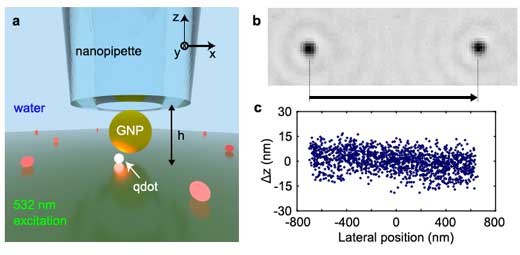| Posted: Jul 20, 2017 | |
Manipulating plasmonic nanoantennas in water enhances fluorescence(Nanowerk News) In new work reported in ACS Nano ("Levitated Plasmonic Nanoantennas in an Aqueous Environment"), researchers in Germany demonstrated the application of an electrostatically confined gold nanoantenna for plasmonic enhancement of fluorescence in aqueous environments. |
|
 |
|
| (a) Schematic illustration of the experimental setup. An 80 nm GNP electrostatically trapped between a scannable nanopipette and a substrate is scanned across a CdSe/CdS giant quantum dot embedded in a PMMA layer in an aqueous bath. The fluorescence signal of individual quantum dot is collected by a total internal reflection microscope. (b) Interferometric scattering (iSCAT) detection images showing a guided single gold nanoparticle by lateral scanning of a nanopipette placed at height h ∼ 140 nm. (c) Axial variations of the GNP in the trap during the scan trajectory depicted in panel b. (© ACS) | |
| Plasmonic nanoantennas have attracted much attention in the past decade both from the fundamental and technological points of view because of their potential in a number of areas such as the enhancement of the Raman scattering cross section or the enhancement of the absorption cross section and the modification of the spontaneous emission rate. | |
| While the great majority of the existing efforts have concerned dry conditions, plasmonic effects have also begun to be used in the liquid phase, giving rise to the emergence of plasmofluidics. | |
| A particularly promising area of application for plasmofluidics is in biophysics and biosensing, where biological nanoparticles and macromolecules diffuse or undergo directed transport. | |
| Recently, the researchers fro Max Planck Institute for the Science of Light, and Friedrich Alexander University of Erlangen-Nürnberg have reported on trapping of small gold nanoparticles at the junction between a glass nanopipette and a glass substrate in water (Nature Communications, "Scanning-Aperture Trapping and Manipulation of Single Charged Nanoparticles") based on a geometry-induced electrostatic potential. | |
| In this new work, they show that this technique can yield a considerable plasmonic enhancement of fluorescence from a single semiconductor quantum dot in water within a lateral range well below 100 nm. | |
| "While we demonstrated this for stationary semiconductor quantum dots embedded at an interface, our experimental platform can also be used for diffusing fluorophores, for example, when they act as a label for proteins or lipids in biomembranes," the authors conclude their report. "Adaptation of the trap geometry to support asymmetric antennas such as nanorods will also allow rotational diffusion studies." |
 By
Michael
Berger
– Michael is author of three books by the Royal Society of Chemistry:
Nano-Society: Pushing the Boundaries of Technology,
Nanotechnology: The Future is Tiny, and
Nanoengineering: The Skills and Tools Making Technology Invisible
Copyright ©
Nanowerk LLC
By
Michael
Berger
– Michael is author of three books by the Royal Society of Chemistry:
Nano-Society: Pushing the Boundaries of Technology,
Nanotechnology: The Future is Tiny, and
Nanoengineering: The Skills and Tools Making Technology Invisible
Copyright ©
Nanowerk LLC
|
|
|
Subscribe to a free copy of one of our daily Nanowerk Newsletter Email Digests with a compilation of all of the day's news. |
